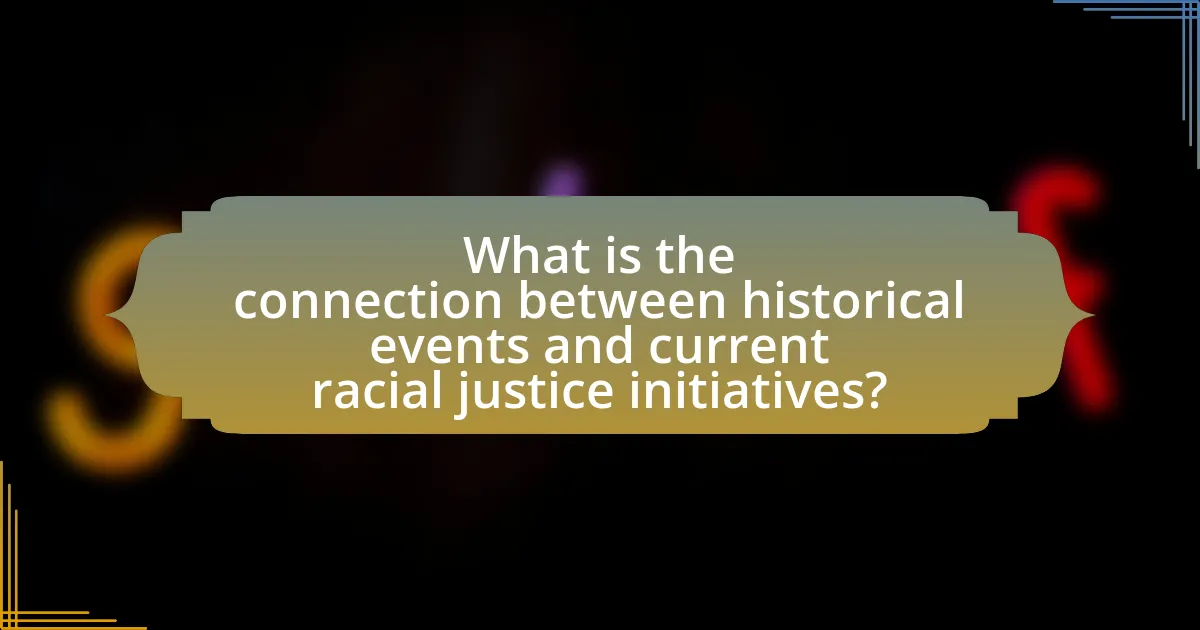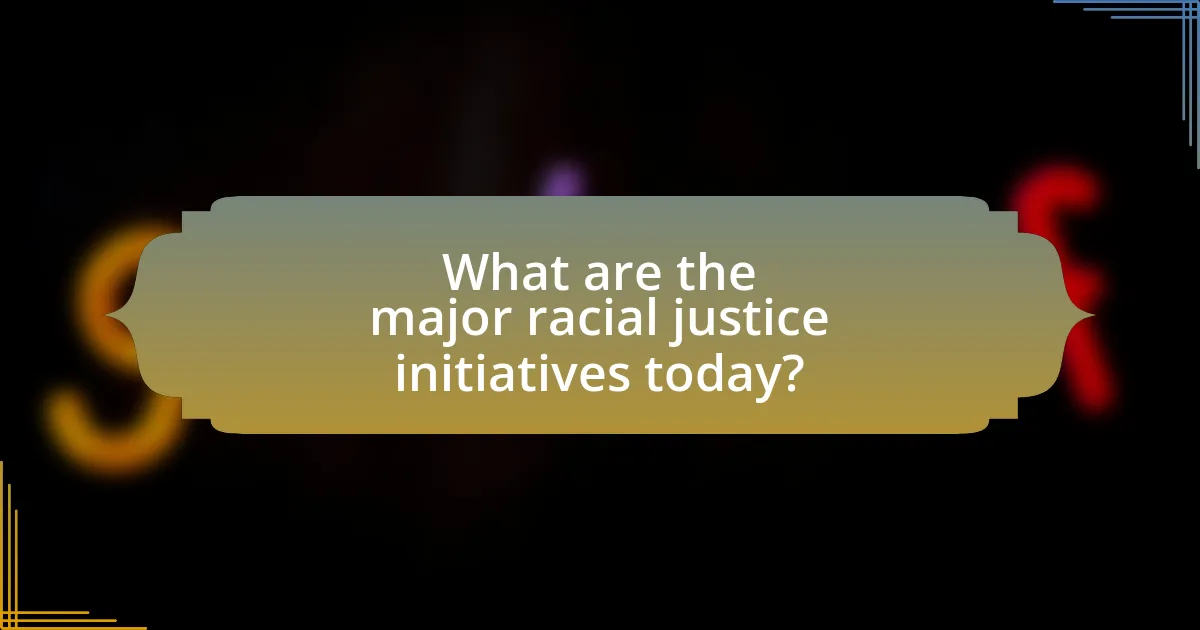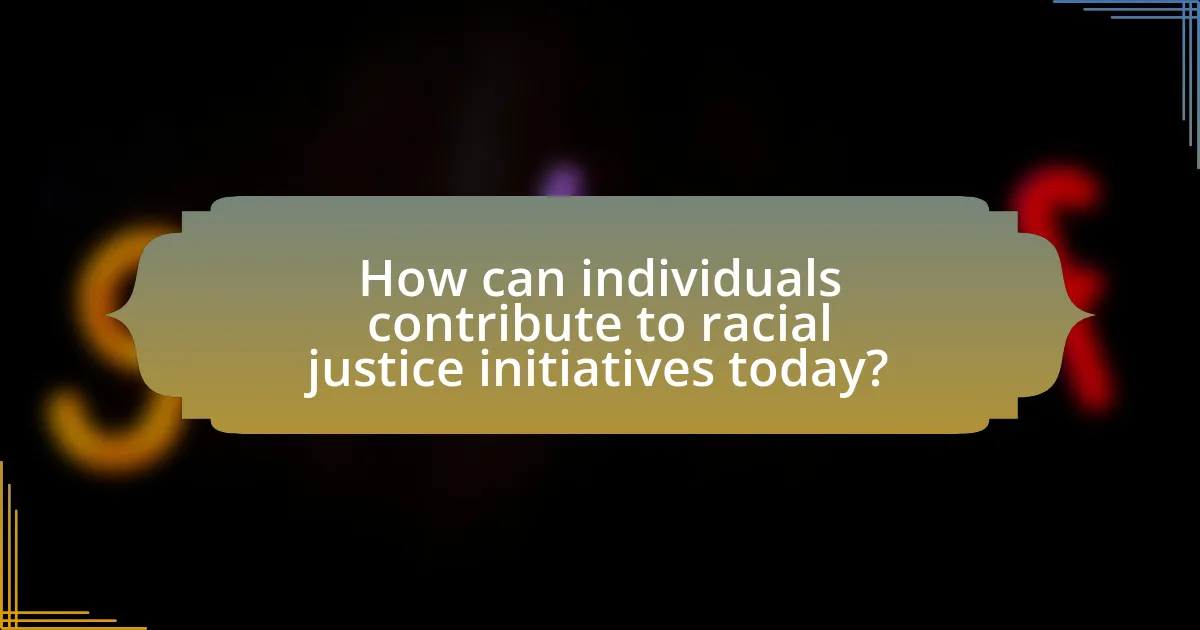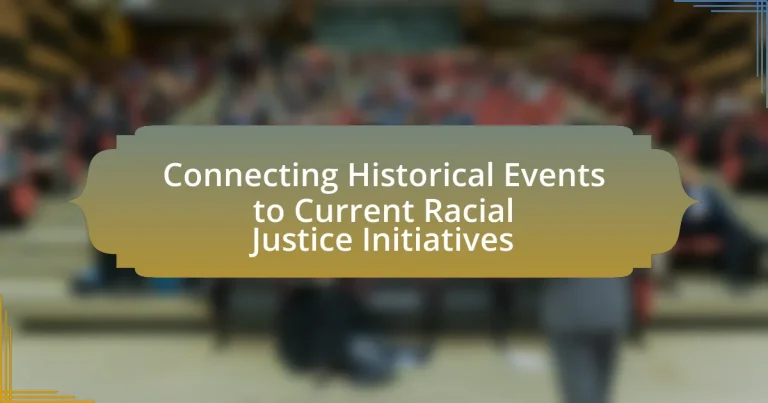The article examines the connection between historical events and current racial justice initiatives, highlighting how past struggles inform contemporary activism. It discusses pivotal moments such as the Civil Rights Movement, the abolition of slavery, and landmark legislation like the Civil Rights Act of 1964, which have shaped the landscape of racial justice today. The piece emphasizes the importance of understanding historical context in addressing systemic inequalities and outlines the role of grassroots movements in advocating for change. Additionally, it explores how current initiatives reflect historical injustices and the strategies individuals can employ to contribute to racial justice efforts.

What is the connection between historical events and current racial justice initiatives?
Historical events significantly shape current racial justice initiatives by providing context and motivation for activism. For instance, the Civil Rights Movement of the 1960s, which aimed to end racial segregation and discrimination against African Americans, laid the groundwork for contemporary movements like Black Lives Matter. This modern initiative addresses systemic racism and police violence, echoing the struggles faced during the Civil Rights era. Additionally, landmark legislation such as the Civil Rights Act of 1964 serves as a legal foundation that current initiatives build upon to advocate for equality and justice. The historical context of racial oppression informs the strategies and goals of today’s racial justice efforts, demonstrating a direct lineage between past struggles and present activism.
How have historical events shaped the landscape of racial justice today?
Historical events have significantly shaped the landscape of racial justice today by establishing legal frameworks and social movements that address systemic inequalities. The Civil Rights Movement of the 1960s, for instance, led to landmark legislation such as the Civil Rights Act of 1964 and the Voting Rights Act of 1965, which aimed to dismantle segregation and protect voting rights for African Americans. These legislative changes laid the groundwork for ongoing advocacy against racial discrimination and have influenced contemporary movements like Black Lives Matter, which seeks to address police violence and systemic racism. Additionally, historical events such as the abolition of slavery and the Jim Crow laws have created a legacy of activism and awareness that continues to inform current racial justice initiatives, emphasizing the need for equity and inclusion in society.
What key historical events are pivotal in understanding current racial justice movements?
Key historical events pivotal in understanding current racial justice movements include the Civil Rights Movement of the 1960s, the abolition of slavery in 1865, and the Voting Rights Act of 1965. The Civil Rights Movement, marked by significant protests and legal challenges, aimed to end racial segregation and discrimination against African Americans, leading to landmark legislation such as the Civil Rights Act of 1964. The abolition of slavery fundamentally altered the social and economic landscape of the United States, setting the stage for ongoing struggles for equality. The Voting Rights Act of 1965 was crucial in dismantling barriers to voting for African Americans, reinforcing the importance of political representation in racial justice efforts. These events collectively inform the strategies and goals of contemporary racial justice movements, highlighting the ongoing fight against systemic racism and inequality.
How do these events influence public perception and policy regarding racial justice?
Events such as protests, police violence incidents, and high-profile court cases significantly influence public perception and policy regarding racial justice. These occurrences often catalyze widespread media coverage and public discourse, leading to increased awareness and urgency around racial issues. For instance, the Black Lives Matter movement gained momentum following the deaths of individuals like George Floyd and Breonna Taylor, prompting millions to participate in protests and advocate for systemic change. This public outcry has resulted in policy shifts, such as the introduction of police reform bills in various states, reflecting a growing demand for accountability and equity in law enforcement practices. Additionally, surveys indicate that public support for racial justice initiatives has surged, with a 2020 Pew Research Center study showing that 67% of Americans believed that the country needed to do more to achieve racial equality. Such events not only shape societal attitudes but also drive legislative action aimed at addressing racial disparities.
Why is it important to analyze historical context in racial justice initiatives?
Analyzing historical context in racial justice initiatives is crucial because it provides insight into the systemic inequalities and injustices that have shaped current societal structures. Understanding the historical backdrop, such as the legacy of slavery, segregation, and discriminatory laws, allows advocates to identify the root causes of racial disparities and tailor initiatives effectively. For instance, the Civil Rights Movement of the 1960s highlighted the need for legal reforms to address racial discrimination, which informs contemporary policies aimed at promoting equity. By examining past events and their impacts, stakeholders can develop informed strategies that address not only the symptoms but also the underlying issues of racial injustice.
What lessons can be learned from past racial justice movements?
Past racial justice movements teach the importance of sustained activism and coalition-building. For instance, the Civil Rights Movement of the 1960s demonstrated that organized efforts, such as the Montgomery Bus Boycott and the March on Washington, effectively mobilized public support and led to significant legislative changes, including the Civil Rights Act of 1964. Additionally, these movements highlight the necessity of addressing intersectionality, as seen in the inclusion of women and LGBTQ+ individuals in the fight for racial equality. Historical evidence shows that movements that embraced diverse voices were more successful in achieving comprehensive social change.
How does historical context inform current strategies for racial justice?
Historical context informs current strategies for racial justice by providing a framework for understanding systemic inequalities and the evolution of civil rights movements. For instance, the legacy of slavery, Jim Crow laws, and the Civil Rights Movement of the 1960s shape contemporary discussions on policies like affirmative action and police reform. Historical events, such as the Voting Rights Act of 1965, highlight the ongoing struggle for equitable representation, influencing current advocacy for voting rights protections. Additionally, the historical context of racial violence and discrimination informs community-led initiatives aimed at healing and reconciliation, emphasizing the need for restorative justice practices. These historical insights guide activists and policymakers in crafting strategies that address both the root causes and the manifestations of racial injustice today.

What are the major racial justice initiatives today?
Major racial justice initiatives today include the Black Lives Matter movement, which advocates against systemic racism and police violence, and the Movement for Black Lives, which focuses on policy reforms to address racial inequities. Additionally, initiatives like the Justice in Policing Act aim to reform law enforcement practices, while organizations such as the NAACP and ACLU work on legal advocacy for civil rights. These initiatives are supported by data showing persistent racial disparities in areas like criminal justice, education, and healthcare, highlighting the ongoing need for comprehensive reform.
How do current initiatives reflect historical struggles for racial equality?
Current initiatives reflect historical struggles for racial equality by addressing systemic injustices that have persisted over time. For example, the Black Lives Matter movement, which emerged in response to police violence against Black individuals, echoes the civil rights protests of the 1960s aimed at combating racial discrimination and advocating for equal treatment under the law. Additionally, contemporary policies such as affirmative action and reparations discussions are rooted in historical demands for equity and justice, highlighting the ongoing fight against the legacy of slavery and segregation. These initiatives demonstrate a continuity of activism that seeks to rectify past wrongs and promote social justice, reinforcing the idea that the struggle for racial equality is both a historical and a current issue.
What similarities exist between past and present racial justice movements?
Past and present racial justice movements share key similarities, including the use of grassroots organizing and advocacy to challenge systemic racism. Both movements mobilize communities to demand equal rights and social justice, often employing protests, marches, and public demonstrations as primary tactics. For instance, the Civil Rights Movement of the 1960s utilized mass protests and sit-ins to combat segregation and discrimination, paralleling contemporary movements like Black Lives Matter, which similarly employs protests to address police violence and racial inequality. Additionally, both movements emphasize the importance of coalition-building across diverse groups to amplify their messages and achieve broader societal change.
How do current initiatives address the legacies of historical injustices?
Current initiatives address the legacies of historical injustices by implementing policies aimed at reparative justice, education, and community empowerment. For instance, various governments and organizations are establishing reparations programs that provide financial compensation or resources to communities historically marginalized, such as African American descendants of enslaved individuals. Additionally, educational initiatives are being developed to incorporate accurate historical narratives into school curricula, fostering awareness of past injustices and their ongoing impacts. Research from the American Psychological Association indicates that such educational reforms can significantly improve societal understanding and reduce systemic biases. Furthermore, community empowerment programs focus on enhancing access to resources, such as housing and healthcare, which directly address the socio-economic disparities rooted in historical injustices. These multifaceted approaches demonstrate a commitment to rectifying past wrongs and promoting equity in contemporary society.
What role do grassroots movements play in current racial justice initiatives?
Grassroots movements are essential in current racial justice initiatives as they mobilize communities, raise awareness, and advocate for systemic change. These movements often emerge from local communities, allowing individuals to voice their experiences and demands directly, which fosters a sense of ownership and urgency in addressing racial inequalities. For instance, the Black Lives Matter movement, which began as a grassroots response to police violence, has significantly influenced public discourse and policy changes regarding racial justice, demonstrating the power of collective action. Additionally, grassroots organizations often engage in voter registration drives and community education, which are critical for empowering marginalized populations and ensuring their voices are heard in the political process.
How have grassroots movements evolved from historical events to present day?
Grassroots movements have evolved significantly from historical events to the present day, transitioning from localized efforts to organized, global networks. Historically, movements such as the Civil Rights Movement in the 1960s utilized community organizing and direct action to combat racial injustice, exemplified by events like the March on Washington in 1963, which mobilized over 250,000 people advocating for civil rights. In contemporary times, grassroots movements leverage digital platforms and social media to amplify their reach and coordinate actions, as seen in the Black Lives Matter movement, which gained international attention following the 2014 protests in Ferguson, Missouri, after the shooting of Michael Brown. This evolution reflects a shift from traditional, in-person mobilization to a more interconnected and rapid-response approach, allowing for broader participation and immediate dissemination of information.
What impact do grassroots movements have on policy changes related to racial justice?
Grassroots movements significantly influence policy changes related to racial justice by mobilizing public support, raising awareness, and pressuring lawmakers. For instance, the Black Lives Matter movement has led to legislative reforms such as the George Floyd Justice in Policing Act, which aims to address police misconduct and systemic racism. Research shows that grassroots activism can shift public opinion, as seen in a 2020 Pew Research Center survey indicating that 67% of Americans supported the movement’s goals, prompting local governments to reconsider policing policies and practices. These movements create a platform for marginalized voices, driving policy discussions and fostering accountability among elected officials.

How can individuals contribute to racial justice initiatives today?
Individuals can contribute to racial justice initiatives today by actively participating in advocacy, education, and community engagement. Advocacy can involve supporting policies that promote equity, such as voting for candidates who prioritize racial justice or participating in campaigns that challenge systemic racism. Education is crucial; individuals can educate themselves and others about racial issues, historical injustices, and the importance of diversity and inclusion. Community engagement can take the form of volunteering with organizations focused on racial justice, attending local meetings to voice concerns, or supporting minority-owned businesses. According to a 2020 report by the Pew Research Center, 76% of Americans believe that racial and ethnic discrimination is a major problem, highlighting the need for individual action to address these issues.
What actions can individuals take to support racial justice initiatives?
Individuals can support racial justice initiatives by actively participating in advocacy, education, and community engagement. Advocacy can include contacting local representatives to express support for policies that promote racial equity, such as criminal justice reform or anti-discrimination laws. Education involves learning about systemic racism and sharing that knowledge with others, which can help raise awareness and foster informed discussions. Community engagement can take the form of volunteering with organizations focused on racial justice, attending local events, or supporting minority-owned businesses. According to a 2020 report by the Pew Research Center, 76% of Americans believe that racial discrimination is a major problem, highlighting the importance of individual actions in addressing these issues.
How can understanding historical context enhance individual contributions to racial justice?
Understanding historical context enhances individual contributions to racial justice by providing a framework for recognizing systemic inequalities and their origins. This awareness allows individuals to identify patterns of oppression and resistance throughout history, such as the Civil Rights Movement, which informs current advocacy efforts. For instance, knowledge of landmark legislation like the Civil Rights Act of 1964 helps individuals understand the ongoing struggles against discrimination and motivates them to engage in contemporary initiatives aimed at promoting equity. By contextualizing current issues within a historical narrative, individuals can better articulate their positions, mobilize communities, and contribute effectively to racial justice efforts.
What resources are available for individuals looking to engage in racial justice work?
Individuals looking to engage in racial justice work can access a variety of resources, including organizations, educational materials, and community initiatives. Notable organizations such as the NAACP, Race Forward, and the American Civil Liberties Union provide extensive resources, including toolkits, training programs, and advocacy guides. Educational platforms like Coursera and edX offer courses on racial justice topics, enabling individuals to deepen their understanding and skills. Additionally, local community groups often host workshops and events focused on racial equity, providing opportunities for direct involvement and networking. These resources collectively support individuals in effectively contributing to racial justice efforts.
What are the best practices for advocating for racial justice in today’s society?
The best practices for advocating for racial justice in today’s society include educating oneself and others about systemic racism, engaging in community organizing, and supporting policies that promote equity. Education fosters awareness of historical injustices and current disparities, which is essential for informed advocacy. Community organizing mobilizes individuals to work collectively towards common goals, as seen in movements like Black Lives Matter, which has effectively raised awareness and influenced policy changes. Supporting equitable policies, such as those aimed at criminal justice reform or equitable education funding, is crucial for creating systemic change. According to a 2020 report by the Pew Research Center, 76% of Americans believe that addressing racial inequality is important, highlighting the societal demand for effective advocacy.
How can individuals effectively communicate the importance of historical context in racial justice advocacy?
Individuals can effectively communicate the importance of historical context in racial justice advocacy by utilizing specific historical examples that illustrate the ongoing impact of systemic racism. For instance, referencing the Jim Crow laws and their legacy can help explain current disparities in education and employment opportunities for marginalized communities. Historical data, such as the fact that Black Americans were denied the right to vote until the Voting Rights Act of 1965, underscores the necessity of understanding past injustices to address present inequalities. By integrating these concrete examples into discussions, advocates can create a compelling narrative that emphasizes the relevance of history in shaping contemporary racial justice issues.
What strategies can be employed to mobilize communities around racial justice initiatives?
To mobilize communities around racial justice initiatives, strategies such as grassroots organizing, coalition building, and community education can be employed. Grassroots organizing involves engaging local leaders and residents to identify specific racial justice issues affecting their community, fostering a sense of ownership and urgency. Coalition building brings together diverse groups, including civil rights organizations, faith-based communities, and local businesses, to create a unified front that amplifies voices and resources. Community education initiatives, such as workshops and forums, raise awareness about historical injustices and current racial disparities, empowering individuals with knowledge to advocate for change. Research shows that communities with strong grassroots movements, like the Black Lives Matter movement, have successfully mobilized large-scale protests and policy changes, demonstrating the effectiveness of these strategies in driving racial justice initiatives.


